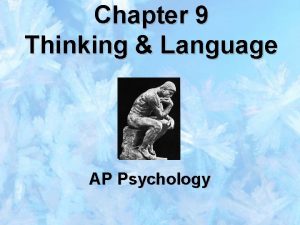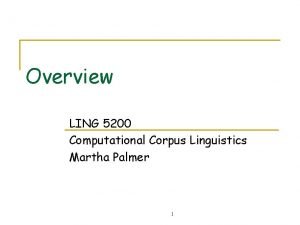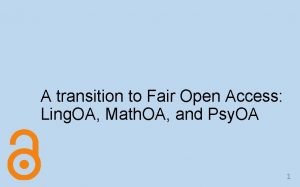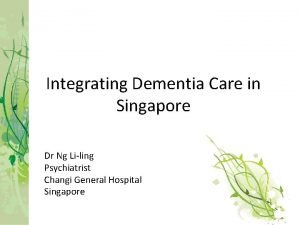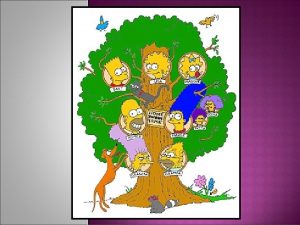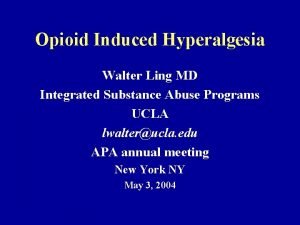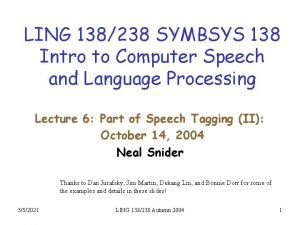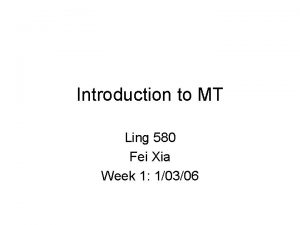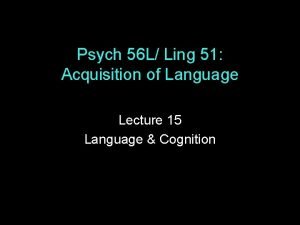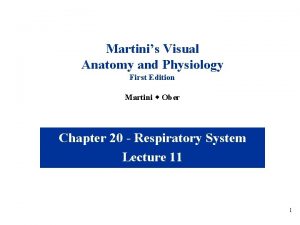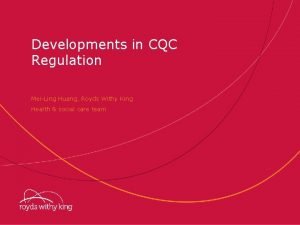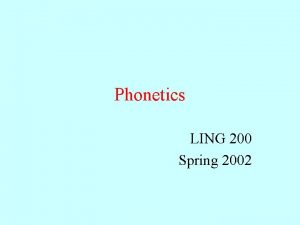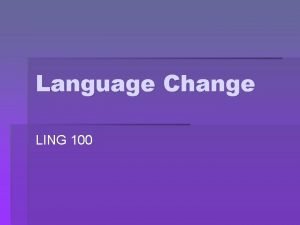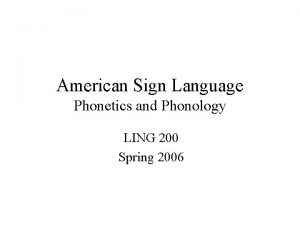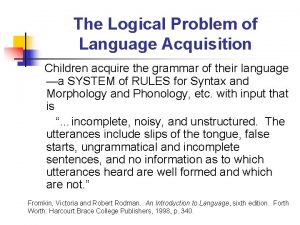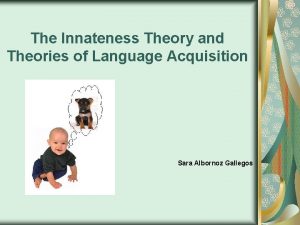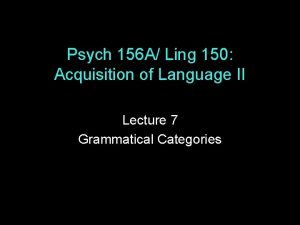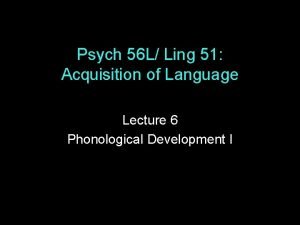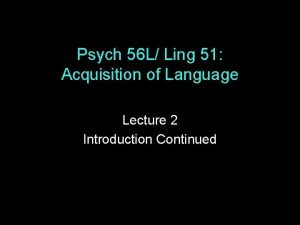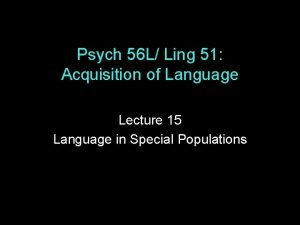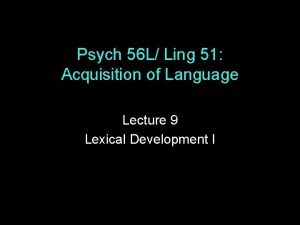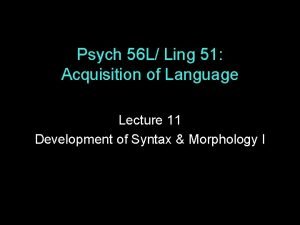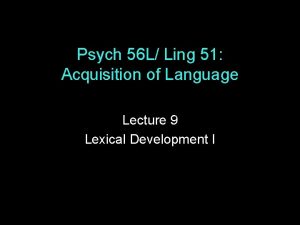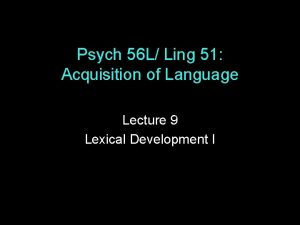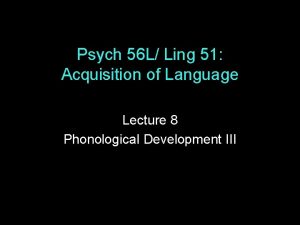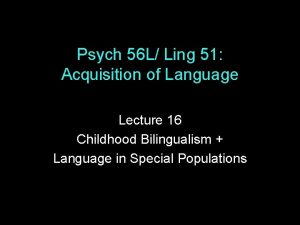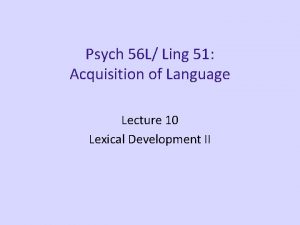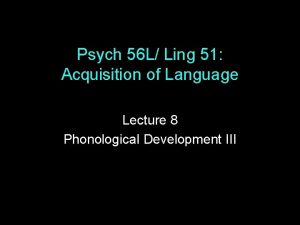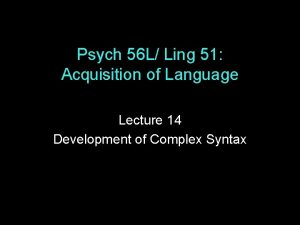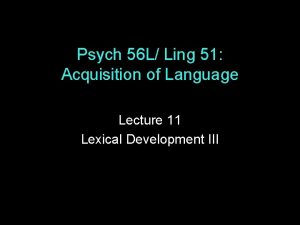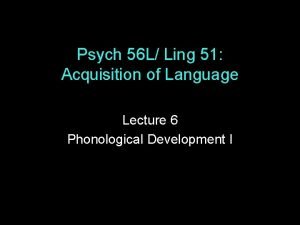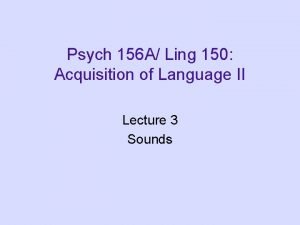Psych 56 L Ling 51 Acquisition of Language









































- Slides: 41

Psych 56 L/ Ling 51: Acquisition of Language Lecture 4 Biological Bases of Language II

Language Localization

Why the left hemisphere? Left hemisphere may process information more analytically. Trained musicians process music in the left hemisphere. Normal (untrained) people process it on the right. Left hemisphere may be better at executing well-practiced routines, while right is better at responding to novel stimuli. Language, for adults, is a well-practiced routine.

Where is language located? Not-just-left hemisphere evidence Sometimes, aphasia doesn’t result when there is left hemisphere damage. Sometimes, aphasia results when there is right hemisphere damage. In some people (usually left -handed people), language is controlled by the right hemisphere.

Where is language located? Not-just-left hemisphere evidence Right hemisphere contributions to language: tone contour, emotional tone, jokes, sarcasm, figurative language interpretation, following indirect requests (much of this falls under pragmatics) Evidence: right hemisphere lesion patients Right hemisphere activated by semantic processing, while left hemisphere activated primarily by syntactic processing Evidence: ERP studies Evidence: late language learners who aren’t as proficient with syntax, and have language located primarily in right hemisphere

How does a left hemisphere specialization for language develop? Equipotentiality hypothesis: left and right hemispheres have equal potential at birth Prediction: dichotic listening and brain injury in children show less specialization for language than adults Invariance hypothesis: left hemisphere specialization available at birth Prediction: dichotic listening and brain injury data from children should look like the corresponding data from adults

How does a left hemisphere specialization for language develop? f. MRI studies: newborns and 3 -month-old infants show greater lefthemisphere than right-hemisphere activation in response to speech stimuli (as do adults) - But also greater left-hemisphere activity in response to nonspeech sounds, suggesting general bias to process sounds in left hemisphere (older children [10 -month-olds] and adults process non-speech sounds with right hemisphere)

How does a left hemisphere specialization for language develop? Dichotic listening tasks: Right-ear advantage for verbal stimuli in 2 -year-olds Speech vs. non-speech? Best (1988): right-ear advantage for consonants but not for vowels. Consonants have rapidly changing acoustic properties compared with vowels. Could tie in to left-hemisphere specialization for serial processing.

How does a left hemisphere specialization for language develop? Summary from experimental studies: Language processing appears to be specialized to the left hemisphere as early as researchers can test it. But the infant brain is not the same as the adult brain specialization/lateralization continues to increase as the brain matures.

How does a left hemisphere specialization for language develop? Childhood aphasia: Aphasia nearly always results from left hemisphere damage and rarely from right hemisphere damage (Woods & Teuber 1978) However, immature brain is not organized the same way as the mature brain. - children more likely to suffer Broca’s aphasia (non-fluent aphasia) than Wernicke’s - children tend to recover better from brain damage, with younger children recovering better than older children

Neural plasticity in children Plasticity: the ability of parts of the brain to take over functions they ordinarily would not serve - ex: right hemisphere taking over language functions if left hemisphere is damaged. However, plasticity isn’t the perfect solution - ex: subtle syntactic impairments in these cases suggest that the right hemisphere isn’t as good at parts of language as the left hemisphere is.

Neural plasticity in children How plasticity works: The child’s brain has much redundancy (extra synaptic connections. ) Maturation = pruning unnecessary connections What’s necessary: what gets used (where child’s brain activity is). Once connections are pruned, redundancy is lost and particular functions become localized.

Neural plasticity in children But wait - young children use their right hemisphere (somewhat) for language. Since there’s language activity, why does the right hemisphere lose its language functionality? Maturation hypothesis: adult language brain structures develop in the left hemisphere and take over (specialization is genetically determined) Process change hypothesis: children change the way they process language, and the new way is more in line with the left hemisphere natural capacities. (specialization is by-product of process change)

The Critical Period Hypothesis

Critical & sensitive periods “critical period for language” = biologically determined period during which language acquisition must occur in order for language to be learned fully and correctly Other biologically determined deadlines: - imprinting: chicks & ducklings follow first thing they see forever (it’s likely their mommy) - visual cells in humans: if cells for both eyes don’t receive visual input during the first year or so of life, they lose the ability to respond to visual input “sensitive period”: biologically determined period during which learning must occur for development to most likely happen correctly

Critical & sensitive periods How do we test for a critical period for language acquisition?

Critical & sensitive periods How do we test for a critical period for language acquisition? Ideal experiment: deprive children of all linguistic input during the purported critical period and see how language development occurs. Problem: ideal experiment isn’t so ideal ethically or logistically (just ask the Egyptians)

Critical & sensitive periods How do we test for a critical period for language acquisition? Some historical cases that have unintentionally provided lack of linguistic input to children: “wild children”: like Victor of Aveyron Problem: the lack of language may be due to other reasons

Critical & sensitive periods How do we test for a critical period for language acquisition? Some historical cases that have unintentionally provided lack of linguistic input to children: Lenneberg (1967): “the only safe conclusions to be drawn from the multitude of reports is life in dark closets, wolves’ dens, forests, or sadistic parents’ backyards is not conducive to good health or normal development”

Critical & sensitive periods How do we test for a critical period for language acquisition? One success story for lack of linguistic input with a young child: Isabelle 1930 s: 6 -year-old Isabelle discovered hidden away in a dark room with a deafmute mother as her only contact. She was taught to speak and by age 8, appeared to be normal. Potential implication: Isabelle discovered before critical period was over.

Critical & sensitive periods How do we test for a critical period for language acquisition? A more thorough study: Genie 1970 s: 13 -year-old Genie brought by her mother to social services after escaping mentally ill father; until mother’s escape, had no language input (and very horrific living conditions) By age 17, she had a 5 -year-old’s vocabulary, and could express meanings by combining words together.

Critical & sensitive periods How do we test for a critical period for language acquisition? A more thorough study: Genie However…syntactic skills lagged far behind - deficient in both production and comprehension. “Mama wash hair in sink. ” “At school scratch face. ” “I want Curtiss play piano. ” “Like go ride yellow school bus. ” “Father take piece wood. Hit. Cry. ” Dichotic listening tasks showed language was a righthemisphere activity for her.

Critical & sensitive periods How do we test for a critical period for language acquisition? A more thorough study: Genie Potential Implication: Genie discovered after critical period was over. However, Genie may have had other cognitive disabilities…

Critical & sensitive periods How do we test for a critical period for language acquisition? Late acquisition of sign language (ASL): deaf-of-hearing children whose parents don’t know sign language. Children are eventually exposed to sign language when they encounter other deaf children. Good: individuals have normal early childhood experience, except for lack of language input

Critical & sensitive periods How do we test for a critical period for language acquisition? If critical period is true, children who learn from infancy should be better than children who learned later - this is what Newport (1990) found. Children who were 4 -6 when first exposed were far superior in their sign language ability to children who were exposed after age 12.

Critical & sensitive periods How do we test for a critical period for language acquisition? Late acquisition of sign language (ASL): deaf-of-hearing children whose parents don’t know sign language. Children are eventually exposed to sign language when they encounter other deaf children. Also important: not just about how long sign language speakers had known the language. Speakers who had been signing for more than 30 years showed this same difference: those exposed younger were far superior in their language skills to those exposed when they were older.

Critical & sensitive periods How do we test for a critical period for language acquisition? Second language learning. Why? Children who learn a second language when they are young often become indistinguishable from their native-born peers.

Critical & sensitive periods How do we test for a critical period for language acquisition? Testing age differences in second language acquisition: - Oyama (1976): testing Italian immigrants learning English age of arrival was better predictor of accent than how many years the immigrant had been speaking English - Oyama (1978): age of arrival was better predictor of comprehension than number of years speaking the language (not just about motor skill learning ability)

Critical & sensitive periods How do we test for a critical period for language acquisition? Testing age differences in second language acquisition: - Singleton & Newport (1989): testing grammatical competency of Chinese & Korean natives living in the US Heard recorded voices speaking sentences, and had to judge whether they were correct or not. “The farmer bought two pig at the market. ” “Tom is reading book in bathtub. ”

Second-language proficiency dependent on age of arrival

Critical vs. sensitive, revisited If there is a truly a critical period of language acquisition, people learning language after this period should not succeed very well at all while people within the critical period should do very well. Expectation: discontinuous function of performance critical period language acquisition performance age

Critical vs. sensitive, revisited However, experimental evidence (Hakuta, Bialystok, & Wiley 2003) suggests that there is a smoother drop-off, and also a relation to education-level. (support for sensitive)

So why are younger children better? One idea: genetically determined critical/sensitive period Another factor: dominant language switch hypothesis Younger children are better able to make the new language their dominant language (better at new language than old language) Another factor: self-consciousness about making errors & identification with the new language

So why are younger children better? “Less is more” hypothesis: Newport (1991) Children can remember less than adults (and have other cognitive limitations, like less attention). Perhaps language is actually easier to figure out if the input is limited to smaller chunks. Adults remember more and can store longer chunks, which makes their analytical task harder. Studies supporting a limitation on children’s input leading to better learning performance: Pearl & Lidz, in prep. , Pearl 2008, Pearl & Weinberg 2007, Dresher 1999, Lightfoot 1991

Genetic Basis of Language Development

Heritability of individual differences Twin studies: assess how similar/different monozygotic (identical) and dizygotic (fraternal) twins are Stromswold (2001): heritable factors account for 25 -50% of variance in normal children’s language abilities; 50 -60% of variance in impaired children’s language abilities

Heritability of individual differences Twin studies: assess how similar/different monozygotic (identical) and dizygotic (fraternal) twins are Difference between grammatical and lexicon development: genetic factors account for 25% of syntactic differences and 5% of variance among vocabulary (Stromswold 2006). In general, biological contribution to syntactic development is greater than biological contribution to lexical development.

Genetics of language impairment Language impairment runs in families. - language-impaired children are far more likely to have language-impaired family members - monozygotic twins are more likely to share a language impairment

Genetics of language impairment Language impairment runs in families. - KE family (16 of 30 members had language impairment) - affected members had poor language abilities and severe difficulties with the motor skills involved with speech production - single dominant gene appeared to be the cause: mutation on gene that affects encoding of protein FOXP 2 (Fisher 2006) …however, this is only one genetic part of language development

In summary… There does seem to be a strong biological/genetic component of language development - but it’s certainly not the only factor involved. Moreover, while at least one specific genetic component involved with language development has been developed, it’s still unknown how this component interacts with the rest of the genetic makeup of an individual to produce normal linguistic development.

Questions?
 Acquisition vs learning examples
Acquisition vs learning examples Scienze della formazione
Scienze della formazione Mental grouping of similar objects
Mental grouping of similar objects Jin ling cigarettes
Jin ling cigarettes Tərpənən blok
Tərpənən blok Ling
Ling Erin ling
Erin ling Ling oa
Ling oa Mei-ling from singapore was preparing
Mei-ling from singapore was preparing De bart simpson
De bart simpson Dr ng li ling
Dr ng li ling Nien-ling wacker
Nien-ling wacker Ling shih fu
Ling shih fu Ling simpson
Ling simpson Ling adder
Ling adder Johann basedow the father of gymnastics
Johann basedow the father of gymnastics Walter ling
Walter ling Ling
Ling Ling
Ling Ling
Ling Mt ling
Mt ling Lam wai ling
Lam wai ling Ling oa
Ling oa Wang ling relationship
Wang ling relationship Shi sheng ling
Shi sheng ling Ling rolled
Ling rolled Right atrium
Right atrium Language
Language Cheung yin ling
Cheung yin ling Magic lam
Magic lam Tree and lung
Tree and lung Example of long term plans
Example of long term plans Mei-ling huang
Mei-ling huang Ling 200
Ling 200 Ling internet
Ling internet Agnes ling
Agnes ling Ling 100
Ling 100 Ida ling
Ida ling Minimal pair asl
Minimal pair asl Logical problem of language acquisition
Logical problem of language acquisition Innateness theory of language
Innateness theory of language Language
Language


